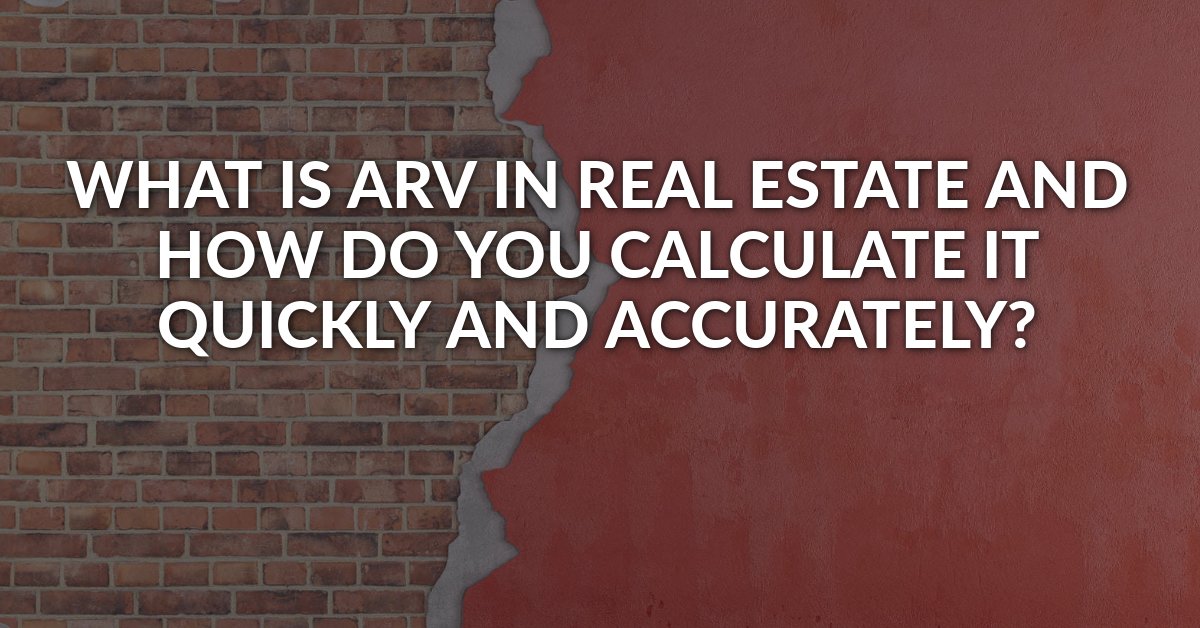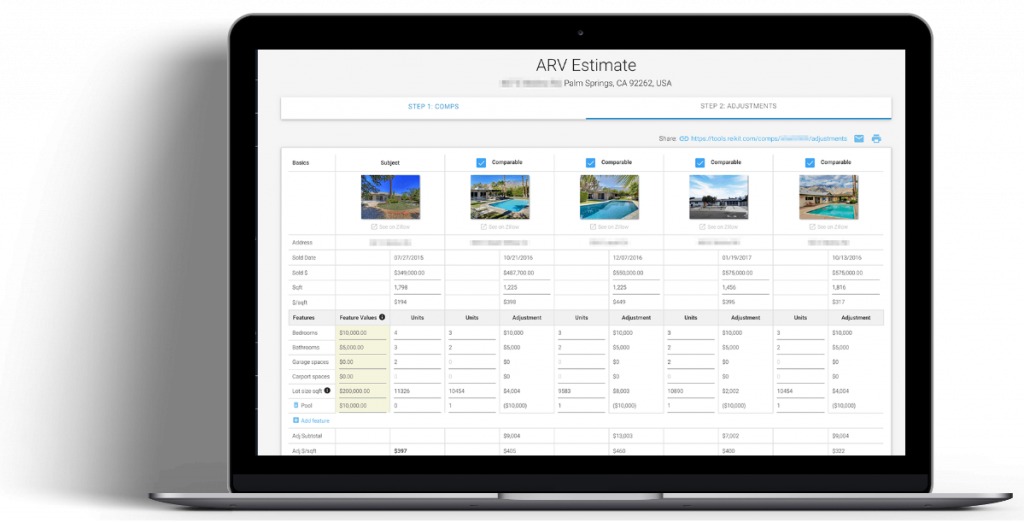
When it comes to investing in real estate, whether a fix and flip, wholesale deal, or rental property, knowing the ARV and how to calculate it is the most important skill that you can build.
That’s because ultimately, being able to quickly and accurately calculate the ARV will aid in your decision to submit an offer on a property, or move on to the next one, without wasting precious time.
Being the most important number of your deal, you should never trust anyone else to come up with the correct ARV value for you, and so in this article you’ll learn the best way to estimate ARV for a property.
Summary of What’s Covered in This Guide
- What is ARV real estate?
- Why do you need to calculate the ARV?
- Why you should avoid automated property valuations?
- What is the ARV real estate formula?
- What are the 3 methods of calculating ARV in real estate?
- Method #1: Calculate the ARV formula using the Value of Renovations
- Method #2: Most investors calculate the ARV using a Comparative Market Analysis
- Method #3: The best way to calculate the ARV uses a Sales Comparison Analysis
- What are the steps to calculate the ARV using a Sales Comparison Analysis?
- Step #1: Perform a CMA by selecting the most appropriate comps using appraisal criteria
- Step #2: Adjust the comps to make them look like your property
- Step #3: Calculate the ARV using adjusted sales prices
- What tools can you use to perform a Sales Comparison Analysis?
Let’s begin with the meaning of ARV in real estate.
What is ARV Real Estate?
ARV meaning in real estate stands for After Repair Value and is an estimation of the future sales price of a property that is purchased for the purpose of fixing up and reselling for a profit.
The ARV is the estimated market value of a property after repairs and upgrades have been performed.
ARV in real estate investing is best determined by first using a Comparative Market Analysis (CMA) to select appropriate real estate comparables, and then improved upon by using a Sales Comparison Analysis, to get to the most accurate value.
Why do you need to calculate the ARV?
There are a number of reasons why you need to know the After Repair Value of every property you are considering putting an offer on.
To have confidence in purchase decisions
It may be tempting to rely on people who are “experts” be it a real estate agent or wholesaler, to tell you the value of a potential property, but when valuing real estate you must always ‘trust, but verify.’
Depending on your exit strategy, you might find that others will cherry-pick comps that are skewed towards the outcome that they are trying to achieve, which may not be in line with your goals.
It is better to learn how to estimate the value on your own, so that you have confidence in your purchase decision.
To determine real estate profit
The After Repair Value will be the target sales price of your finished project, so you will use it as one component of a formula to determine the potential profit of the deal, and whether to go through with it.
To calculate your real estate profit for a flip or potential rental property, use this formula that includes ARV calculations:
Profit = ARV – Purchase Costs – Holding Costs – Sale costs – Rehab Costs
All of your project costs (Purchase, Sale, Holding Costs, and Rehab costs) are subtracted from the After Repair Value to find the profit.
To use the 70% Rule in Real Estate to Estimate the Maximum Purchase Price
Another important use for the ARV in real estate is in calculating the maximum that a real estate investor should offer on property to a seller.
Real estate investors should use this Maximum Purchase Price formula following the 70 rule as follows:
Maximum Purchase Price = (ARV x .70) – Rehab Costs
You can read an in-depth analysis of the 70% rule for flipping houses, including the Maximum Purchase Price formula and how it is a good rule of thumb.
Additionally, you can use this handy 70 percent rule calculator to help you quickly estimate your purchase price.
Now that you know the “why” of ARV estimation, and before I move on to the different methods of estimating it, I wanted to briefly discuss why you should never use an Automated Valuation Method like the Zestimate, Redfin estimate, Trulia estimate… any automated value estimate.
Why you should avoid automated property valuations
Appraisal is part science, part art. Part of that art is looking beyond bedrooms and bathrooms, and looking at the differences in features, and adjusting for quality of construction and finishings.
Although Machine Learning models are getting smarter each day, these are data points that are not yet available to automated valuation mechanisms, and require a certain level of human judgment.
Zillow’s data, for example, can be more than a year behind and is not useful in calculating current value.
So when you have incomplete data, and old data, there is no way that the machine will give you an accurate value.
Similarly Trulia is owned by Zillow, and they use the same data to come up with their valuation.
While Redfin’s data is more current and complete, they too suffer from not having the complete picture, and therefore cannot give you an accurate valuation.
This is why you should always investigate your comps thoroughly online if at all possible:
Take a look inside the comp via property photos. Read the listing description. Use Google Streetview to “walk” the comps and see what the neighborhood looks like. Use any information you can find that will help you determine whether a comp should be included in your analysis for the most accuracy.
Bottom line, just don’t do it. Take the time to get an accurate value by vetting your comps with your own two eyes, and save yourself and your wallet from disaster.
On that note, REI/kit software for house flipping and wholesaling is not designed to give you an automated valuation, rather it is designed to make it quick and easy for you to find the most accurate ARV using appraisal best practices.
You can use the REI/kit ARV calculator for free, with free demo comps to see how powerful this tool can be, and if you opt for a paid subscription, you will get access to premium high quality comps that are suitable for valuation, to ensure that you will have the most accurate ARV.
Let’s move on to the potential ways to formulate an ARV.
What is the ARV real estate formula?
This is the “technically correct” formula to calculate the After Repair Value. It relies on a determination of the current value of the property, as well as a detailed value for all of the planned renovation items.
The ARV Formula is:
After Repair Value = (Current Unrepaired Value of the Property) + (Value of Renovations)
I’ll discuss why this formula should not be relied on to find the ARV of your property, and what you should use instead.
What are the 3 methods to finding ARV in real estate?
There are actually three ways to determine the After Repair Value in real estate investing:
Method #1: By calculating the ARV formula using the value of renovations
As mentioned above, this is the “technically correct” ARV formula touted by 100% of real estate investing blogs out there, and it is obvious that their writers have not actually done any investing. It is supposedly achieved by performing a value analysis of other properties in their current unrepaired state, and then adding the value of planned improvements.
Method #2: By performing a Comparative Market Analysis
This is used by virtually 99% of investors out there. It is accomplished by means of a Comparative Market Analysis, or CMA for short, of sold repaired properties to come up with a market value of properties similar to yours.
Method #3: By performing a Sales Comparison Analysis
This is only done by the top 1% of investors, and is accomplished following appraisal best practices. It requires performing the CMA in #2 above and then adjusting the values of those comps to remove any differences between the comps and your potential property to get the true market value of that property.
I’ll explore the pros and cons of these three methods next.
Method #1: Calculate the ARV formula using the Value of Renovations
There are two steps to using the ARV formula:
- Come up with comparable properties in a similar state of disrepair, and perform a value analysis for the subject property in its unrepaired state.
- Come up with the estimated repairs, and the value (not the cost) of each of those repairs.
It is obvious that anyone that tells you this formula, has never invested in a single property, as this formula is completely impossible to implement in practice. It is considerably difficult and time consuming to determine the value of hundreds of repair and upgrade items for a potential property.
Only armchair real estate investors and blog writers use this formula.
Which option do most investors use then? 99% of investors end up using a Comparative Market Analysis, and you’ll see in a minute, that even this does not give you a complete picture of the value of your property.
Let’s take a quick look at what that means.
Method #2: Most investors calculate the ARV using a Comparative Market Analysis
CMA’s are traditionally used by real estate agents for retail sellers, to estimate at what price a house would sell for on the market. A CMA valuation is created by identifying recent and similar sold houses around the seller’s house and averaging their sale prices.
The concept is the same for an investment property; you find properties that recently sold and have similar features and other characteristics, and use those comparables to value a property.
Despite the fact that creating a CMA is often used by realtors for their real estate investor clients, it is still not a complete valuation.
This is because a CMA is only accurate if all of the comparable properties are the same as your subject property, and unless you are looking at sales in the same planned development community, generally this is not the case, and the comps will be different enough that they will need to be adjusted.
Unfortunately most realtors and investors will rarely take the extra crucial step of adjusting the comps in a sales comparison analysis, which is Method #3.
Method #3: The best way to calculate the ARV uses a Sales Comparison Analysis
The best way to calculate the ARV of an investment property accurately is the Sales Comparison Analysis method.
A sales comparison analysis is a standard technique used by most appraisers. This technique revolves around performing a CMA with real estate comparables that are in a finished state, and adjusting them with the values of the features that are different between them.
Before I explain how to adjust comps, I’ll give a brief overview on what adjusting comps is from an appraiser’s viewpoint.
What is adjusting real estate comps in a Sales Comparison Analysis?
Comps adjustment is the process of determining whether a particular feature makes a comp either superior, or inferior, to the subject property, and adjusting the sales price of the comp upwards or downwards by the amount of that feature’s value.
By doing this, you ensure that the comps reflect the subject’s characteristics (or lack thereof) as closely as possible, and so your calculations are as accurate as possible.
For example, when your potential investment does not have a garage, but a comp does, the comp is superior to the subject regarding that feature.
You would then adjust the sales price of the comp downward by the amount of a garage feature, to reflect the fact that the subject does not have a garage.
One way to think of this is, “If the comp were being sold that same day, without the garage, how much would it have sold for?”
Important tip: You never adjust the price or features of the subject property, only the features and sales price of the comparables.
If this sounds like a lot of work, it is — but only if you don’t have ARV software like REI/kit to make it easy for you.
As you become better at adjustment, comps research, and get to know the features and feature values in your areas, you will get faster and faster at it. Still, you may be wondering why you should bother, so the following is a real-world example.
Why you should adjust your real estate comps
This is the biggest question I get regarding using standard appraisal methods for calculating After Repair Value in real estate investing:
Why should I adjust the comps when calculating ARV? Why not just average the sales prices of the comps together and be done with it?
Simply put, averaging the sales prices of the comps together without adjusting for features will result in a valuation that is not accurate.
Here’s a simplified example:
Subject: 1000 square feet, no pool, as-is listed price $50,000
Comp 1: 900 square feet, sold for $100,000, has pool
Comp 2: 1100 square feet, sold for $100,000, no pool
Comp 3: 950 square feet, sold for $100,000, has pool
Pool in this neighborhood has a feature value of $20,000.
Unadjusted:
Comp 1: $100,000
Comp 2: $100,000
Comp 3: $100,000
Unadjusted ARV = $100,000+$100,000+$100,000/3=$100,000
Adjusted:
Comp 1: $100,000, adjusted downward by $20,000 due to having pool: $80,000
Comp 2: $100,000, adjustment is $0 due to both subject and comp having no pool
Comp 3: $100,000, adjusted downward by $20,000 due to having pool: $80,000
Adjusted price per square feet: $80,000+100,000
Adjusted ARV = $80,000+$100,000+$80,000/3 = $86,667
If you had proceeded with your as-is 50k investment, you’d be losing money before you even got started because when it came time to sell, your property without a pool would sell for $13,000 less than what you had estimated with your unadjusted ARV.
One other excellent reason to use this technique is the fact that your flip property will ultimately get appraised by a retail buyer before a sale. The closer your value is to the buyer’s purchase price, the less likely the sale will fall through due to a low appraisal.
When you think about how many benefits there are to using this method, and how many potential features there actually are in any given set of real estate comps, you can see why adjustments are vitally important, so let’s get into how exactly you do it.
What are the steps to calculate the ARV using a Sales Comparison Analysis
There are three steps to follow in order to determine ARV of an investment property using a Comparable Sales Analysis.
- Perform a CMA by selecting the most appropriate comps using appraisal criteria
- Adjust the comps to make them look like your property
- Calculate the ARV using adjusted sales prices
Step #1: Perform a CMA by selecting the most appropriate comps using appraisal criteria
In real estate investing terms, the principle of substitution states that a buyer will pay no more for a property than the cost of an equally desirable (and comparable) alternative property.
First you need great real estate comps.
Every premium subscription of REI/kit gives you access to high fidelity comps with a level of detail that you simply won’t have access to on most other sites.
When finding real estate comps, through any source, you should adhere to the following factors as much as possible.
Appraisal criteria for finding real estate comparables:
- Properties recently sold recently, within 3-6 months is best, no more than 12
- Properties whose interior and exterior is similar to your potential property in a completed state
- Properties that are within the boundaries of the neighborhood of your property
- Properties that reflect the level of finishes and upgrades that will be performed
Narrow down to comps that are updated
Once you have a list of comps similar to the property, select only those three to five comps in the same condition that you think your investment property is going to end up in, which is newly rehabbed and updated.
Since it’s not likely you found comps that matched your property in every single way, you will need to adjust the comps.
Step #2: Adjust the comps to make them look like your property
As I mentioned earlier, adjusting comps is one of the most vital aspects of a Sales Comparison Analysis.
Adjusting comps is a four part process:
- Determine the features for the subject and comps
- Assign dollar values to features
- Adjust the feature values of a comp
- Adjust the sales price of that comp up or down
Determine the features for the subject and comps
A feature can be any aspect of a property that is significant and that you can assign a dollar amount. For example, bedrooms, bathrooms, garages, pools, fireplaces, land acreage, and even ocean, mountain or city views are all considered features.
Assign dollar values to features
You will next assign a dollar amount to features that you have identified as being valuable in that market.
For example, a one-car garage in a particular city may be assigned a value of $10,000.
You will use these feature values to adjust your comps.
How to find dollar values for features
Values vary widely between markets, even between neighborhoods, and there isn’t a good data source for this so you will need to come up with your own data for the neighborhood that the subject property is located in.
Fortunately, it’s not too hard to do this.
There are three main ways to find a value for features and amenities:
- You can get local knowledge from a realtor as to those values. You should already have a realtor on your team and should be able to speak freely with them about it. If you don’t have one on your team, you can look at who is known for selling the most properties in a particular neighborhood and call them up about one of their listings.
- If you can’t get the values using the local knowledge route, one trick is to perform a sales comparison analysis with 3 comps that are exactly the same, and a comp that is missing that feature, and then you would be able to check for the difference in value between those.
- Finally, you can use the costs method, which is basically what would it cost to build out a bedroom with new construction, and you can use the rehab estimate tool to itemize the costs to do this. This is the least accurate way, as it doesn’t account for market value, only for cost — which aren’t always correlated.
Additional tips for adjusting comps:
Make sure you are valuing the land as well, if it is a lot of land, or if land tends to be expensive.
Compare similar lot sizes, or adjust for land value.
Adjust the feature values of a comp
Every feature that your potential investment property has, or does not have, must be adjusted for in each comp.
Multiply the value of a comp’s feature by the number of units of a feature it has.
Conversely, apply a negative value if the comp has less than the number of units of a feature that your property has.
So for example if your subject has 2 bedrooms and your comp has 4 bedrooms, then your feature value adjustment for bedrooms would be -(2beds X $10,000) = -$20,000
Adjust the sales price of a comp up or down
Increase or decrease the sold price of a comp upward or downward after adjusting for individual features.
- If your property and the comp have the same number of a feature, the adjusted value is 0.
- If your property has two units of a feature and the comp has one unit of that feature, the comp’s sold price is increased by that feature unit’s value.
- If your property has one unit of a feature and the comp has two units of that feature, the comp’s sold price is decreased by that feature unit’s value.
So for example if your subject had 2 beds and 2 baths, but your comp had 4 beds and 1 bath, then and a bedroom was worth $10,000 and a bathroom was worth $5,000, then your net adjustment to the comp would be:
-(2beds X $10,000) + (1bath X $5,000) = -$20,000+$5,000 = -$15,000
After you have adjusted the value of all three to five comps, it’s time to calculate.
Step #3: Calculate the ARV using adjusted sales prices
Once you have added or subtracted the adjustments from all of your comps’ sales prices, your new comp sales prices will determine the value of the subject property.
In cases where your comps are very similar to your subject property, you can just take the average of the adjusted sales prices of the comps, and this is what the ARV calculator does.
If you were to follow appraisal best practice completely, you may also perform a weighted average of your comps’ adjusted sales prices based on an opinion of how much each comp contributes to the value.
While you can do this adjustment using the ARV calculator by adding another feature that is the weighted average, if you selected your comps correctly in the first place, this ends up as an average anyway, so it’s mostly an unneeded step.
What tools can you use to perform a Sales Comparison Analysis?
You might think the most inexpensive way is to create yourself an after repair value spreadsheet, but you’d be wrong, unless you don’t value your time. Fortunately we have you covered. The free version of the ARV calculator is already designed to help you come up with a sales comparison analysis.
Now of course your analysis is only as good as the data that you put into it, and this is where with a premium subscription to REI/kit you will get some of the best comps in the business to ensure that your ARV will be accurate.
Summary
Real estate investors rely on accurate property valuations to determine if a flip, wholesale, or rental deal is worth pursuing and will result in profits. The trick in calculating ARV in real estate is in understanding the formulas to get to ARV, selecting the right comps, and knowing and adjusting for the values of your most important comparable features.
Performing a thorough Sales Comparison Analysis with adjusted comps on a property to determine the ARV ensures that you are only making offers on deals with potential for success.



